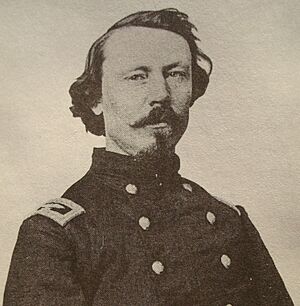Battle of Rome Cross Roads facts for kids
Quick facts for kids Battle of Rome Cross Roads |
|||||||
|---|---|---|---|---|---|---|---|
| Part of the American Civil War | |||||||
|
|||||||
| Belligerents | |||||||
| Commanders and leaders | |||||||
| Grenville M. Dodge | William J. Hardee | ||||||
| Units involved | |||||||
| Army of the Tennessee | Army of Tennessee | ||||||
The Battle of Rome Cross Roads was a small but important fight during the American Civil War. It happened in Gordon County, Georgia, near Calhoun, Georgia, on May 16, 1864. This battle was part of a bigger plan called the Atlanta Campaign. It took place right after a larger battle called the Battle of Resaca.
The main goal for the Confederate army was to slow down the Union Army. This allowed their supply wagons and other troops to get to a safe meeting point. The battle ended with no clear winner. However, the Confederates achieved their goal of delaying the Union forces.
The Battle Begins
Union armies, led by Major General William Tecumseh Sherman, fought the Confederate Army of Tennessee. The Confederates were led by General Joseph E. Johnston. They had just finished the Battle of Resaca, Georgia, from May 13–15, 1864. After two days of tough fighting, Union forces managed to get around the side of the Confederate army. This forced the Confederates to leave their positions at Resaca. Both armies then split into three groups to move faster south.
On May 16, 1864, a Union unit was chasing the retreating Confederates. This unit was the 2nd Division, led by Brigadier General Thomas William Sweeny. They were part of Major General Grenville M. Dodge's XVI Corps. They moved toward a crossroads near Calhoun, Georgia. Their goal was to cut off the Confederate troops led by Lieutenant General William J. Hardee. Hardee's troops and their supply wagons were heading to a meeting point at Adairsville, Georgia.
General Johnston sent Hardee's troops to block the Union advance. This was to protect the Confederate supply wagons. Hardee's Corps set up their defenses in the woods. They were south of the Rome-Calhoun Road, near the crossroads.
Surprise Attack
As the first Union soldiers, called skirmishers, moved toward the crossroads, the Confederates attacked. They launched a surprise attack from the woods. The Confederates drove the Union soldiers back. The Union commander, Captain George Taylor, was killed trying to hold his ground.
Colonel Patrick E. Burke was the commander of the 2nd Brigade. He quickly sent more Union soldiers forward to help. These soldiers managed to stop the Confederate attack. As Colonel Burke was organizing his troops, he was badly wounded. Lieutenant Colonel Robert N. Adams then took command. The Union forces pulled back a short distance. The Confederates then fired artillery at the Union supply wagons.
The Confederates held their position. They successfully delayed the Union advance. This allowed the Confederate supply wagons to pass through Calhoun, Georgia. They continued safely south to Adairsville, Georgia.
The Union forces had about 50 casualties. The loss of Colonel Patrick E. Burke was significant. He was mortally wounded and died soon after the battle.
Aftermath
Hardee's Corps moved toward Adairsville during the early hours of May 17, 1864. On May 17, 1864, the two armies fought again. This happened at the Battle of Adairsville, Georgia, and also in fighting at Rome, Georgia.


